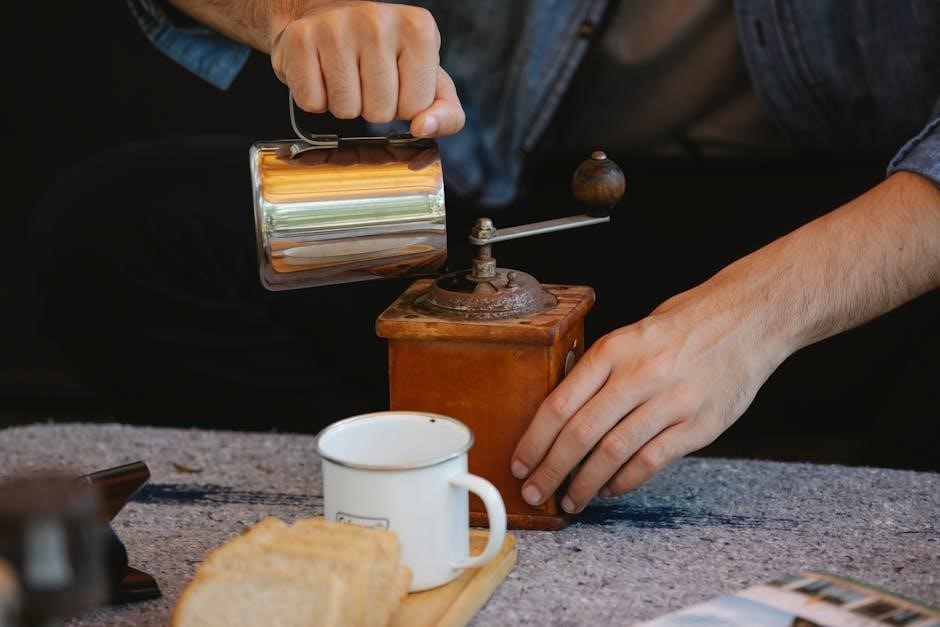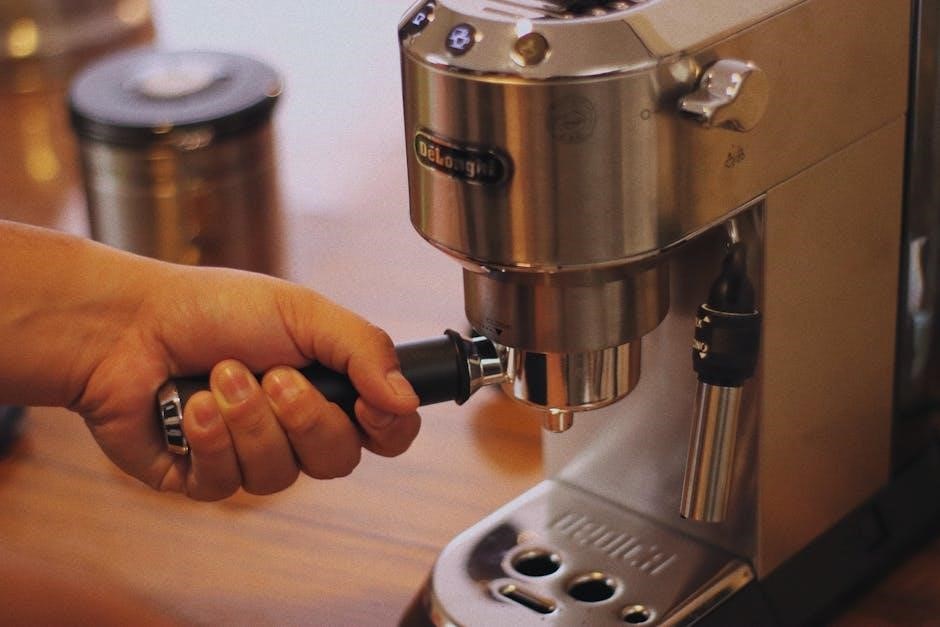Understanding the Coffee Maker
Your coffee maker is a sophisticated appliance designed to brew perfect coffee. It features a heating element, water reservoir, and brewing chamber. Modern designs often include programmable timers, adjustable strength settings, and energy-efficient modes. Familiarize yourself with these components to optimize your brewing experience.
1.1 Components and Features
Your beautiful coffee maker is equipped with essential components designed for optimal performance. The water reservoir holds the water supply, while the heating element ensures precise temperature control. The brewing chamber houses the coffee grounds, and the control panel allows you to customize settings like brew strength and timing. Some models feature a built-in grinder for freshly grinding beans and a milk frother for creating lattes and cappuccinos. Additional features include programmable timers, adjustable cup sizes, and energy-saving modes. The carafe is typically made of glass or stainless steel, keeping your coffee warm for hours. Advanced models may also include features like smartphone app connectivity for remote operation and customizable brewing profiles. Understanding these components will help you make the most of your coffee maker and enjoy a perfect cup every time.

1.2 Design and Aesthetics
The design of your coffee maker is a perfect blend of functionality and style, making it a stunning addition to your kitchen. Available in various finishes such as stainless steel, black, and white, it complements any kitchen decor. The compact and sleek design ensures it fits seamlessly on your countertop without occupying too much space. Many models feature modern touchscreens or LED displays for an elegant and user-friendly interface. Some coffee makers also include customizable lighting to enhance their visual appeal. The curved lines and smooth surfaces give it a sophisticated look, while the high-quality materials ensure durability and a premium feel. Whether you prefer a minimalist or a contemporary style, this coffee maker is designed to be both functional and visually appealing. Its ergonomic design makes it easy to use, with intuitive controls and a clear water level indicator. The thermal carafe is designed to keep your coffee warm for hours while maintaining its sleek appearance. This coffee maker is not just an appliance but a statement piece that reflects your love for great coffee and beautiful design.

Setup and Installation
Begin by carefully unpacking your coffee maker and placing it on a stable, flat surface. Ensure it is away from water sources and heat. Plug in the power cord and allow the machine to reach the optimal temperature before first use.
2.1 Unboxing and Initial Setup
When you unbox your beautiful coffee maker, ensure all components are included: the main unit, carafe, filters, and power cord. Carefully inspect for any damage. Before first use, wash the carafe and brew basket with warm soapy water, then rinse thoroughly and dry. Place the coffee maker on a stable, flat surface, away from direct water sources or excessive heat. Plug in the machine and familiarize yourself with the control panel. Press the power button to activate it and allow it to heat up. Some models may require a brief initial setup, such as setting the clock or selecting your preferred language. Refer to the manual for specific instructions. Once powered on, perform a trial brew without coffee grounds to ensure proper function. This step ensures your coffee maker is ready for daily use. Always follow the manufacturer’s guidelines for initial setup to guarantee safety and optimal performance.

2.2 Placement and Preparation Tips
Choosing the right location for your coffee maker is essential for both functionality and aesthetics. Place it on a stable, heat-resistant countertop, ensuring it is at least 6 inches away from any walls or other appliances to allow proper airflow. Avoid areas near direct sunlight or moisture sources, as these can affect performance and longevity. If your coffee maker has a cord, position it so the cord does not hang over edges or come into contact with water.
Before first use, prepare your space by clearing the countertop of clutter. Ensure the surface is clean and dry to prevent any water spots or damage. Measure and prepare your coffee beans or grounds according to your preferences. Use filtered water to prevent mineral buildup and ensure a clean taste. Store coffee beans in an airtight container to preserve freshness. Keep a scoop, grinder, and any other brewing tools nearby for convenience. Finally, familiarize yourself with the machine’s settings and customization options to tailor your brewing experience. Proper placement and preparation will enhance your coffee-making routine and ensure years of reliable service from your beautiful coffee maker.

Operating the Coffee Maker
Operating your coffee maker involves simple steps for a perfect brew. Add water to the reservoir, measure coffee grounds, and select your preferred brewing settings. Use the control panel to choose brew strength, timer, or specialty options. Press start and enjoy your coffee.
3.1 Brewing Methods and Customization
Your coffee maker offers versatile brewing methods to suit every preference. Choose from drip brewing, espresso, or pour-over options. Customize strength by selecting from strong brew or regular settings. Adjust the grind control to accommodate different coffee beans, from fine to coarse. Explore temperature control to ensure the ideal heat for your brew. For specialty drinks, use the steam wand to froth milk for cappuccinos or lattes.
Enhance your experience with programmable features. Set a timer to brew coffee exactly when you need it. Use the delay start function for added convenience. Experiment with pre-brew soaking to release optimal flavors. Customize cup sizes from espresso shots to travel mugs. The machine also allows you to adjust water hardness and enable eco-mode for energy efficiency.
For the best results, use freshly ground beans and filtered water. Explore the coffee-to-water ratio to find your perfect balance. Clean the machine regularly to maintain performance. With these features, your coffee maker empowers you to craft a truly personalized brewing experience every time.
3.2 Daily Use and Maintenance Tips
For optimal performance, follow these daily use and maintenance tips. Always use fresh, filtered water to prevent mineral buildup and ensure better-tasting coffee. Before brewing, rinse the coffee basket and carafe with warm water to remove any residual flavors or odors. After each use, wipe down the brewing area and control panel with a damp cloth to maintain hygiene.
Regularly clean the water reservoir and internal pipes to prevent scaling and bacterial growth. Activate the machine’s cleaning cycle every 1-2 months, or as indicated by the manufacturer. Check and replace the water filter every 2-3 months to maintain water quality. Descale the machine every 3-6 months, depending on usage and water hardness, to prevent mineral deposits from affecting performance.
Store the coffee maker in a cool, dry place away from direct sunlight. Avoid using abrasive cleaners, as they may damage the machine’s finish. For consistent results, use the recommended coffee-to-water ratio and adjust settings according to your preferences. By following these tips, you’ll extend the lifespan of your coffee maker and enjoy perfectly brewed coffee every time.

Cleaning and Maintenance
Regular cleaning ensures your coffee maker performs optimally. Run the cleaning cycle, replace water filters, and descale as needed. Wipe surfaces daily, and dry thoroughly after cleaning to prevent moisture buildup. Use manufacturer-recommended cleaning products for best results.
4.1 Daily and Deep Cleaning Procedures
Regular cleaning is essential to maintain your coffee maker’s performance and hygiene. For daily cleaning, rinse the carafe and brewing basket with warm water after each use. Wipe down the machine’s exterior with a damp cloth, paying attention to areas around buttons and lids where residue may accumulate.
For a deeper clean, mix equal parts water and white vinegar in the reservoir and run a brewing cycle. Repeat this process twice to ensure all internal parts are cleaned. Remove any mineral buildup by descaling if necessary. Soak removable parts like the coffee basket and carafe in warm soapy water for 15-20 minutes before rinsing thoroughly.
After cleaning, dry all parts with a clean towel to prevent water spots and bacterial growth. Regular deep cleaning every 1-3 months will prevent scale buildup and keep your coffee tasting fresh. Always refer to your machine’s specific cleaning cycle instructions for optimal results.

4.2 Descaling and Filter Replacement
Descaling your coffee maker is crucial to remove mineral deposits that can affect performance and water flow. Use a descaling solution or white vinegar by running it through the machine as you would water. Repeat the process until the solution is fully cycled, then rinse by running several cycles of clean water to remove any residue.
Replace the water filter every 1-2 months or as recommended by the manufacturer to ensure clean water and optimal taste. Use a compatible filter to maintain water quality and prevent contaminants. If your machine has a built-in filter, clean or replace it according to the manufacturer’s guidelines to avoid reduced efficiency.
After descaling or replacing the filter, brew a few cups of water to rinse the system thoroughly. Regular descaling and filter replacement will extend the lifespan of your coffee maker and ensure consistent flavor in every brew. Always refer to your machine’s specific instructions for recommended products and intervals.

Safety Precautions and Best Practices
Always unplug the coffee maker when not in use or during cleaning. Keep it away from water sources to avoid electrical hazards. Ensure proper ventilation to prevent overheating. Use only original or recommended parts. Read the manual carefully before operation to ensure safe usage and optimal performance.
5.1 General Safety Tips and Handling
Always handle the coffee maker with care to avoid accidental damage or injury. Place it on a stable, heat-resistant surface, away from flammable materials. Keep the appliance out of reach of children and pets. Avoid touching hot surfaces, such as the carafe or brewing area, during operation. Use oven mitts or a towel to handle hot components. Ensure the coffee maker is properly assembled before use. Never leave the machine unattended while it is in operation. Regularly inspect the power cord and plug for damage; if damaged, discontinue use immediately. Avoid overfilling the water tank or coffee grounds container, as this may lead to spills or malfunction. Clean up spills promptly to prevent slipping hazards. Store the coffee maker in a dry place when not in use. Follow the manufacturer’s guidelines for maximum capacity and usage. By adhering to these safety tips, you can ensure a safe and enjoyable coffee-making experience.
5.2 Electrical Safety and Precautions
To ensure safe operation, always plug the coffee maker into a grounded electrical outlet with the correct voltage rating. Avoid using extension cords or adapters, as they may cause overheating or electrical issues. Do not submerge the machine or any electrical components in water, as this can lead to serious safety hazards. Keep the power cord away from hot surfaces or open flames. If the cord is damaged, discontinue use immediately and contact a professional for repair. Never attempt to modify or tamper with the electrical components, as this can void the warranty and pose a risk of electric shock. Always unplug the machine when not in use or during cleaning. Avoid overloading electrical circuits with multiple high-power appliances. Use only genuine replacement parts to maintain electrical safety. Regularly inspect the plug, cord, and outlet for signs of wear or damage. If you notice any unusual odors, sounds, or sparks, stop using the machine and consult a qualified technician. Adhering to these electrical safety precautions will help prevent accidents and ensure long-term functionality of your coffee maker.

Troubleshooting Common Issues
If your coffee maker isn’t functioning properly, check the power supply and ensure all parts are securely connected. Refer to the error codes in the manual for specific guidance. Clean the machine regularly to prevent clogs and maintain performance. If issues persist, contact customer support for assistance.
6.1 Identifying and Resolving Common Problems
Common issues with your coffee maker can often be resolved with simple troubleshooting. If the machine does not turn on, check the power cord connection and ensure it is plugged into a functioning outlet. If water is not flowing, inspect the water reservoir for proper alignment and ensure it is not empty; For incomplete brewing cycles, verify that the coffee grounds basket is correctly placed and that the carafe is positioned under the spout. If the machine is leaking, check for loose connections between the water tank and the brewing unit. If the coffee tastes bitter, adjust the coarseness of the grind or reduce the amount of coffee used. For noise issues, ensure the machine is placed on a stable, even surface. If problems persist, consult the user manual or contact customer support for further assistance.
6.2 Error Codes and Resetting the Machine
Your coffee maker is equipped with a diagnostic system that displays error codes to help identify issues. If you see an error code such as E1, E2, or E3, refer to the user manual for specific explanations. Common codes include E1 for heating element issues, E2 for sensor malfunctions, and E3 for water flow problems. To reset the machine, unplug it from the power source, wait 30 seconds, and plug it back in. This often resolves minor glitches.

- For E1, ensure the machine is clean and descaled. If the issue persists, contact customer support.
- For E2, check the sensor for blockages or misalignment.
- For E3, verify water flow by ensuring the reservoir is filled and properly aligned.
If the machine displays continuous errors, perform a factory reset by holding the power button for 10 seconds while unplugged. This restores default settings. Always consult the manual for code-specific guidance to avoid further complications.